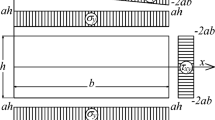Abstract
Based upon a combination of a temporally-piecewise adaptive algorithm with an Element-Free Galerkin Scaled Boundary Method (EFG-SBM), a partitioning algorithm is presented for the two-dimensional viscoelastic analysis of cyclically symmetric structures. By expanding variables at a discretized time interval, the variations of variables can be described more precisely, and a space–time domain-coupled problem can be converted into a series of recurrent boundary value problems which are solved by an EFG-SBM-based partitioning algorithm via an adaptive computing process. Numerical examples are given to verify the proposed algorithm in terms of computing accuracy and efficiency.











Similar content being viewed by others
References
Christensen RM (1982) Theory of viscoelasticity: an introduction. Academic Press, Cambridge
Ahmadi E, Barikloo H, Kashfi M (2016) Viscoelastic finite element analysis of the dynamic behavior of apple under impact loading with regard to its different layers. Comput Electron Agr 121:1–11
Ashrafia H, Shariyata M, Khalilia SMR, Asemib K (2013) A boundary element formulation for the heterogeneous functionally graded viscoelastic structures. Appl Math Comput 225:246 – 62
Han Z, Yang HT, Liu L (2006) Solving viscoelastic problems with cyclic symmetry via a precise algorithm and EFGM. Acta Mech Sinica 22:170–176
Guo XF, Yang HT (2016) A combination of EFG-SBM and a temporally-piecewise adaptive algorithm to solve viscoelastic problems. Eng Anal Bound Elem 67:43–52
Xu QW, Prozzi JA (2015) A time-domain finite element method for dynamic viscoelastic solution of layered-half-space responses under loading pulses. Comput Struct 160:20–39
Kalyania VK, Pallavikab SK, Chakrabortyb (2014) Finite-difference time-domain method for modelling of seismic wave propagation in viscoelastic media. Appl Math Comput 237:133 – 45
Wolf JP, Song Ch (1996) Consistent infinitesimal finite element cell method: three dimensional vector wave equation. Int J Numer Methods Eng 39:2189–2208
Wolf JP, Song Ch (1996) Finite-element modelling of unbounded media. Wiley, Chichester
Wolf JP, Song Ch (2000) The scaled boundary finite-element method—a primer: derivation. Comput Struct 78:191–210
Wolf JP, Song Ch (2001) The scaled boundary finite-element method—a fundamental solution-less boundary-element method. Comput Methods Appl Mech Eng 190:5551–5568
Deeks AJ, Wolf JP (2002) A virtual work derivation of the scaled boundary finite-element method for elastostatics. Comput Mech 28:489–504
Deeks AJ, Augarde CE (2005) A meshless local Petrov-Galerkin scaled boundary method. Comput Mech 36:159–170
Lin G, Lu S, Liu J (2015) Duality system-based derivation of the modified scaled boundary finite element method in the time domain and its application to anisotropic soil. Appl Math Model 40:5230–5255
Ooi ET, Yang ZJ (2010) Modelling crack propagation reinforced concrete using a hybrid finite element-scaled boundary finite element method. Eng Fract Mech 78:252 – 73
Ooi ET, Yang ZJ (2010) A hybrid finite element-scaled boundary finite element method for crack propagation modelling. Comput Method Appl Mech Eng 199:1178–1192
Ooi ET, Yang ZJ (2011) Modelling dynamic crack propagation using the scaled boundary finite element method. Int J Numer Method Eng 88:329–349
Yang ZJ, Deeks AJ, Hao H (2007) Transient dynamic fracture analysis using scaled boundary finite element method: a frequency domain approach. Eng Fract Mech 74:669 – 87
Bazyar MH, Talebi A (2015) Scaled boundary finite-element method for solving nonhomogeneous anisotropic heat conduction problems. Appl Math Model 39:7583–7599
Hell S, Becker W (2015) The scaled boundary finite element method for the analysis of 3D crack interaction. J Comput Sci 9:76–81
Zhong WX, Qiu CH (1983) Analysis of symmetric or partially symmetric structures. Comput Methods Appl Mech Eng 38:1–18
Wu GF, Yang HT (1994) The use of cyclic symmetry in two-dimensional elastic stress analysis by BEM. Int J Solids Struct 31:279–290
Guo XF, He YQ, Yang HT (2015) An EFG-SBM based partitioning algorithm for two-dimensional elastic analysis of cyclically symmetrical structures. Eng Computation 32(2):452–472
Yang HT, Guo XF, He YQ (2015) An EFG-SBM based partitioning algorithm for heat transfer analysis of cyclically symmetrical structures. Finite Elem Anal Des 93:42–49
Chongshuai Wang Y, He H Yang (2016) A piecewise partitioning scaled boundary finite element algorithm to solve viscoelastic problems with cyclic symmetry. Eng Anal Bound Elem 73:120–125
Zienkiewicz OC, Morgan K (1983) Finite element and approximation. Wiley, New York
Shames IH, Cozzarelli FA (1992) Elasitc and inelastic stress analysis. Prentice Hall, Englewood Cliffs
Cai E (1989) The foundation of viscoelastic mechanics. Beihang University Press, Beijing
Belytschko T, Lu YY, Gu L (1994) Element-free Galerkin methods. Int J Numer Methods Eng 37:229–256
Belytschko T, Krongauz Y, Organ D (1996) Meshless methods: an overview and recent developments. Comput Methods Appl Mech Eng 139:3–47
Lin HT, Li CY, Zhang NY (1994) Linear algebra. Tian Jin University Press, Tian Jin
Acknowledgements
The research leading to this paper is funded by NSF [11572068], NKBRSF [2015CB057804], Natural Science Funding of Liaoning Province [201602115].
Author information
Authors and Affiliations
Corresponding author
Rights and permissions
About this article
Cite this article
Guo, X., Yang, H. Solving viscoelastic problems with cyclic symmetry via a temporally adaptive EFG-SB partitioning algorithm. Engineering with Computers 35, 101–113 (2019). https://doi.org/10.1007/s00366-018-0586-6
Received:
Accepted:
Published:
Issue Date:
DOI: https://doi.org/10.1007/s00366-018-0586-6




